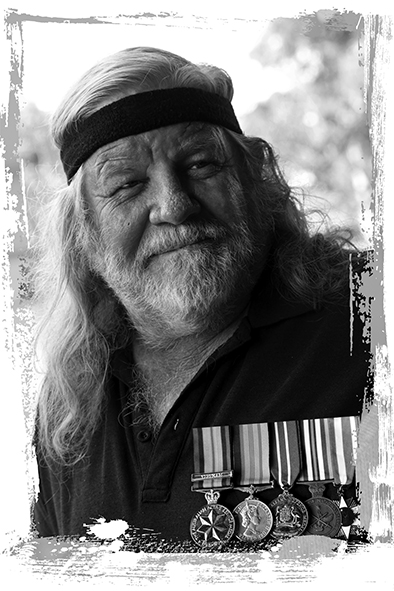Colin D Cahill
Umbugarla, Kakadu
Darwin, Northern Territory
Private
1 Australian Reinforcement Unit
1st Australian Task Force Headquarters
Royal Australian Infantry Corps
Vietnam Veteran
Medals
Australian Active Service Medal 1945-75 – Vietnam
Vietnam Medal
Australian Defence Medal
Anniversary of National Service 1951-72
Republic of Vietnam Campaign Medal
I was born in Darwin in 1947. My Mob’s Umbugarla from Kakadu. My grandfather was Paddy Cahill, protector of Aborigines in Arnhem Land. In 1957 I was taken away by Welfare and sent to Kent Town Boys Home in Adelaide. After a few years, I ran away back up to Darwin and played football for the Darwin Buffaloes and worked on fishing boats. We kept seeing programs about Vietnam on TV and thought we oughta go there and give these fellas a hand. So in 1967 I volunteered for National Service. After training, I was posted to 4th Battalion, Royal Australian Regiment (4 RAR) just as they were going to Vietnam, so I went over with 1 ARU (Australian Reinforcement Unit).
In Vietnam, I was assigned to Defence and Employment (D&E) Platoon 1st Australian Task Force Headquarters in Nui Dat. We did convoy escort and clearing patrols through villages looking for Viet Cong. It was scary at first. I came across an army boot in a field one day. I picked it up, there was a name and number inside. It was my mate’s, Mick Sukmanowsky. He’d been blown to bits by a mine. Each morning, you’d read the casualties in the SITREP (Situation Report). It was bloody heart-wrenching. There were three 4 RAR guys killed, one after the other. I blame myself in a way. I was always the forward scout because they knew if anything was out of whack, I’d pick it straight away. But I hadn’t been there, and they got killed. That’s what still bothers me today, if I’d been in front, would they have got off?
They had us spraying chemicals around the barracks and tents. We were getting really crook, spewing up blood, blacking out. I woke up in hospital, I’d blacked out, and they’d sent me off in a helicopter. We didn’t know what that stuff was called then. We know now, it was Agent Orange.
I came home from Vietnam just in time for the birth of my son. But then I started getting chronic headaches; everything would go black, and I’d wake up on the floor. They put me through X-rays and tests but they couldn’t find anything. My temper would go from my feet to my neck in a split second. After I’d done a barrage of doctors and tests and been sent to hospitals in Adelaide and Sydney, I was diagnosed as having major chronic PTSD with anxiety and depression. But then another doctor said it could be a personality disorder brought on by the Boys’ Home. But I never felt bad about being in the home. I just felt happy to be away from it. I just learned to adapt and wait for my opportunity to get out. I’ve put my case to the Department of Veteran’s Affairs for over 30 years, but I’m still only on the 70% pension.
I only ever went to two ANZAC marches. When I saw our 4th Battalion flag, I just couldn’t go there. I felt like I didn’t really belong because boys died when I wasn’t out in front. It’s a terrible feeling. But one day someone asked me, ‘Are you going to NAIDOC, there’s going to be Aboriginal soldiers there, Geoffrey Shaw will be there.’ Well, he’s one of my best mates, he was in my unit when I joined. When you’re in a strange place, you look out for somebody familiar or somebody from your side of the fence you can have a yarn with. I’d never worn my medals, but my wife pinned them on me that day, and I went and had a good yarn with my good mate Geoffrey.
